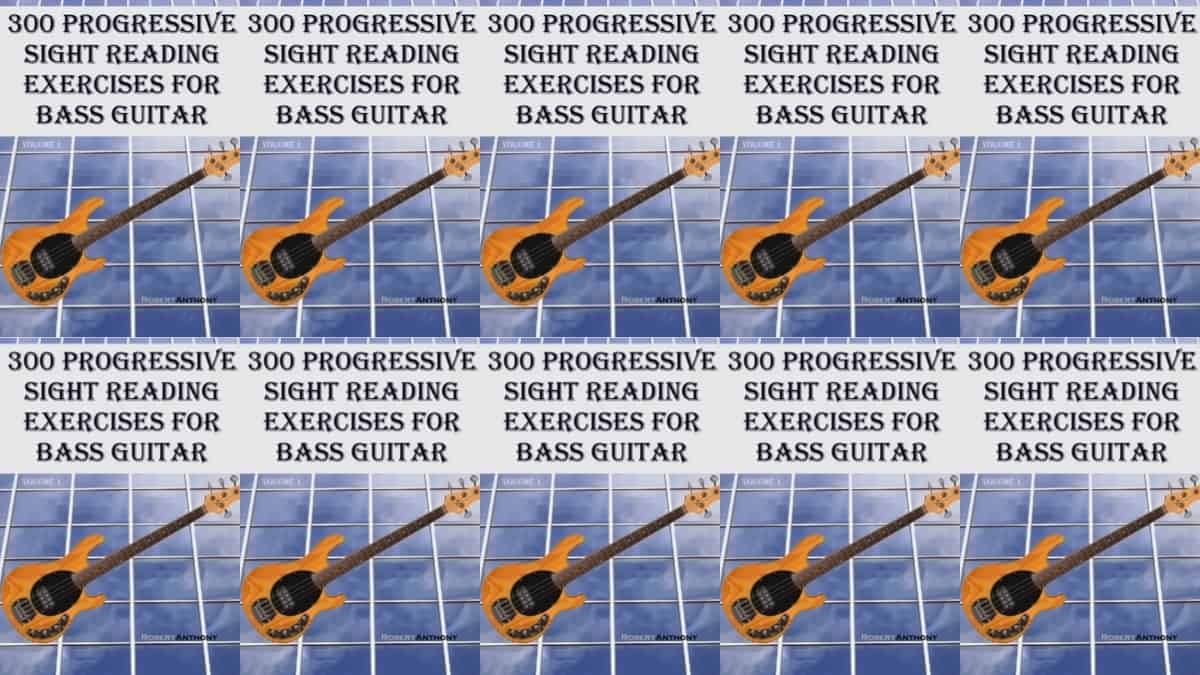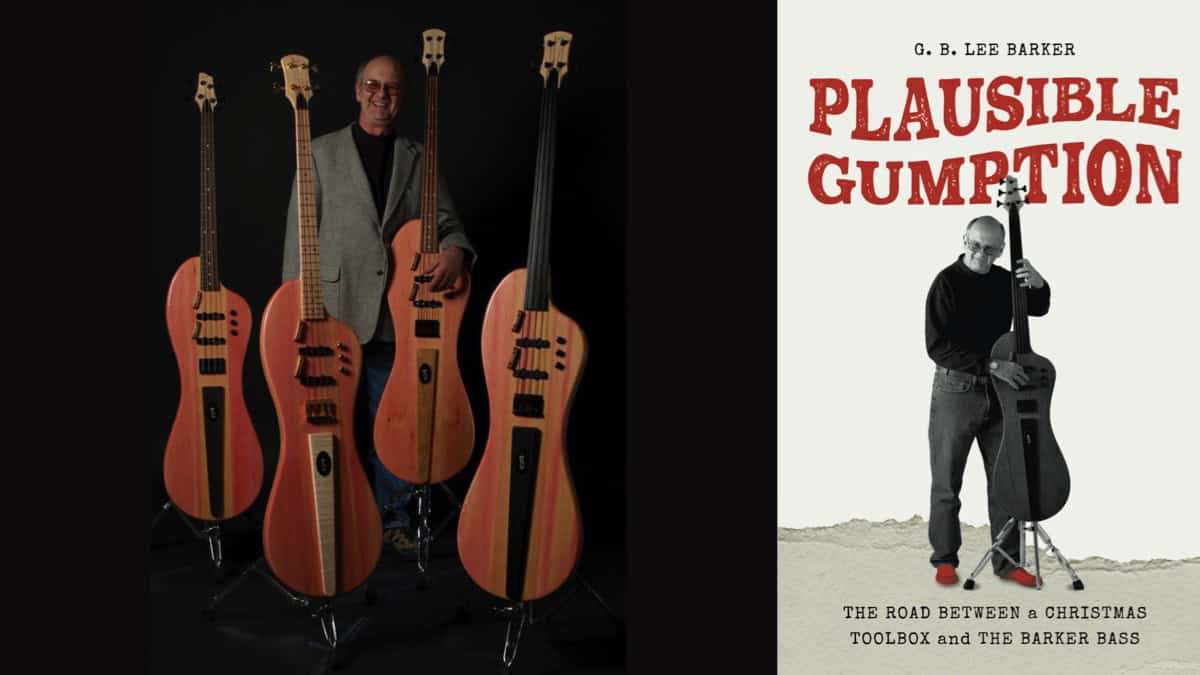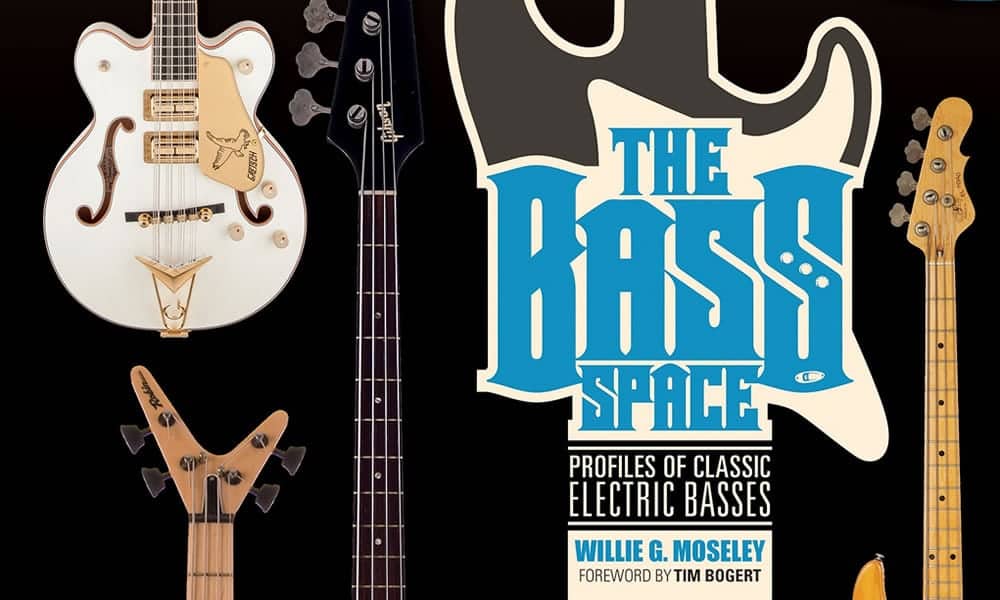Bass Books
300 Progressive Sight Reading Exercises for Bass Guitar

300 Progressive Sight Reading Exercises for Bass Guitar…
First and foremost: THIS IS NOT A METHOD BOOK. It is precisely what it says it is: 300 Progressive Sight Reading Exercises!
Volume One is comprised of 300 progressive eight-bar exercises that cover the keys of C Major, F Major, G Major, A Minor, D Minor, and E Minor. Time signatures include 4/4 (Common Time), 3/4, 2/4, 6/8, and 2/2 (Cut Time). The remaining key signatures, additional time signatures, tempo markings, and dynamics markings will be covered in future volumes.
All of the exercises are eight measures long. If one has done any study of formal analysis, they will find that eight measures is a typical ‘period’ of music and usually contains two, four-bar phrases (also typical in length). For example, many sonatinas, jazz standards, and pop songs use “32 Bar Form” (A A B A), “Binary Form” (A B), and “Ternary Form” (A B A), with each section, often being eight bars. Thus, eight measures (one period of music) make the perfect length for sight-reading studies in my opinion.
How to use this book: Start where the exercises begin and work across the book — from exercises 1, 5, 9, 13, and so on until you get to a point where the music challenges you, and then mark your ending point. For the next practice, play exercises 2, 6, 10, 14, and so on… The next: 3, 7, 11, 15, and so on, and finally 4, 8, 12, 16, and so on. If you want to work at your “breakpoint” (the point in the book where you can no longer play musically), work DOWN the page instead of across the pages.
Note: This book is also available in a LARGE PRINT version that for printing purposes had to be divided into two books. If you have poor vision or want this book to be easy to SEE on an electronic device, you might prefer the Large Print Version.
“These books differ from conventional ‘methods’ in that technical and theoretical instructions have been omitted, in the belief that these are more appropriately left for the teacher to explain to the student.” — Bela Bartok, Mikrokosmos.
I wholeheartedly agree with Bartok’s sentiment and if music teachers would ask their students what they like least (or hate the most) about typical lessons, it is the method books that win this contest EVERY TIME. I have completely eliminated method books from my own teaching practice and have much happier and more productive students than ever.
While this book is intended to train sight-reading skills, it may also be used by beginners or those new to reading to acquire basic reading skills, but it assumes one either has a teacher or can at least find C on their instrument. It starts at a very basic level (only three notes) and adds a new note, rhythm, or concept to every four exercises and thoroughly reinforces them throughout the rest of the book.
Next, the music’s composition is a slave to its function: The purpose of the books is to train reading skills, and the exercises keep challenging the range that has been established by previous exercises as well as less-than-convenient intervallic skips. They are composed from a ‘music-first’ perspective, as opposed to an ‘instrument-first’ perspective, and are purposely composed to be difficult to memorize.
For example, the first exercises begin on C because they are in the key of C, and then go on to sometimes start and end on different scale degrees of the same key. Those familiar with the Fundamental Modes will likely recognize what they are hearing, but those unfamiliar with these modes will likely be hearing something that sounds a bit different, or odd until their ears acclimate to these sounds. I see many students go through this process with altered dominants and augmented triads as well.
Additionally, a 20th-century composition technique (Bartok, Stravinsky) — Serial Composition — has also been used on several of the pieces, so if your ears are unfamiliar with this type of music, you might at first be uncomfortable with what you are hearing.
300 Progressive Sight Reading Exercises for Bass Guitar is available at Amazon.com
Bass Books
Interview With Barker Bass’s Inventor and Writer Lee Barker

If you are an electric bass player, this is an exciting time to be alive as this relatively new instrument evolves around us. Some creative individuals have taken an active role in this evolution and made giant leaps in their own direction. Lee Barker is one of these inventive people having created the Barker Bass.
Fortunately, Lee is also an excellent writer (among so many talents) and has recently released his book “Plausible Gumption, The Road Between a Christmas Toolbox and The Barker Bass”. This book is a very fun read for everyone and shares a ton of details about Lee’s life in general, his experiences as a musician, a radio host, and a luthier. Now I am fortunate to have the great opportunity to gain even more insights into this renaissance man with this video interview.
Plausible Gumption, The Road Between a Christmas Toolbox and The Barker Bass is available online at Amazon.com
Bass Books
Ultimate Look at Electric Basses from 1930 to Today

The Bass Space: Profiles of Classic Electric Basses.
The definitive book for lovers of the low-end. Willie G. Moseley, Senior Writer for Vintage Guitar Magazine, profiles more than 100 historic and unique electric bass models from such makers as Alembic, Danelectro, Fender, Gibson, Gretsch, Guild, Hamer, Kramer, Rickenbacker, and many others.
Rare and legendary instruments, from the earliest attempts at amplified basses in the mid-1930s to the cutting-edge instruments of today, are presented in more than 250 color and period photos.
The main feature of this book is the exclusive coverage of historic and one-of-a-kind basses owned and played by such famed musicians as: Bill Black (Elvis Presley), Tim Bogert (Vanilla Fudge), Mark Egan (Pat Metheny Group), John Entwistle (The Who), Paul Goddard (Atlanta Rhythm Section), Bruce Hall (REO Speedwagon), Greg Lake (Emerson, Lake & Palmer), Benjamin Orr (The Cars), Tom Petersson (Cheap Trick), Carl Radle (Derek and the Dominos), Gene Simmons (Kiss), Steve Wariner, and others.
The Bass Space: Profiles of Classic Electric Basses is available online at Amazon.com
Bass Books
Review: The Bastard Instrument, A Cultural History of the Electric Bass by Brian F Wright

I was intrigued when The Bastard Instrument showed up on my desk… let’s dig in!
When we dive into the history of our beloved instrument, the bass, we find roots that go back as far as the 15th century. This instrument was a member of the violin family and was for the longest time, an acoustic instrument. As the years passed and music changed, there was a need for the instrument to evolve and the electric bass was born.
Comparatively, the electric bass is a relatively new instrument with its earliest appearances dating back to the 1930s and it is exciting to be an electric bass player while this history unfolds around us. Fortunately for us and future generations to come, Professor Brian F. Wright has taken on the herculean task of documenting the trajectory of the electric bass with this excellent book.
The Bastard Instrument presents an extraordinary amount of fine details about the instrument itself, the development of the amplification to handle its output, the pioneers that dared play it, the rapidly evolving music that flourished because of its presence and so much more.
When I first started reading this book, I noticed that it felt a tad academic, like a textbook (it might be one someday) or a doctoral thesis, but to present all this information accurately, this approach is more than appropriate. Another detail that might be a bit of a spoiler is that the book only gets us up to the late ’60s. I was left wanting more as we know that so much has happened in the bass world since that time frame; I hope there is another volume in the works to get us up to the present!
All in all, “The Bastard Instrument, A Cultural History of the Electric Bass” is a must-read for all of us who play electric bass and understand its essential place in music.
I found that there was a lot that I already knew but also quite a bit that I was unaware of. I believe that to know and understand where you are, you must know the history of exactly how you got here.
Highly recommended.
The Bastard Instrument is available at Amazon.com (beginning July 2024)
Bass Books
Review: The Bassist’s Complete Guide to Injury Management, Prevention and Better Health

The Bassist’s Complete Guide to Injury Management, Prevention and Better Health
I have often thought that it would be great if the doctors who delivered us as newborn babies provided us with a user manual to help us navigate through life in the best way possible. Now Dr. Randall Kertz, D.C. has produced a manual specifically designed to address the many possible afflictions plaguing us bass players.
Many of you will remember volumes 1 & 2 of this book and our first review in 2007. The new complete guide combines the two volumes and features over 20 pages of new material including interviews, techniques, and conditions.
If you play bass, you can read this book cover to cover and walk away with a ton of relevant and helpful knowledge. Another option is to search out issues relevant to you specifically (I found quite a few of my own with helpful options). This is possible because the book is very nicely organized into six chapters that address Pain, Conditions, Techniques, Road Issues, Inspirational Q&A with some of the biggest names in the bass community (too many to list here) and finally How to get relief.
All said, this book is essential if you play either electric or upright bass to the point where they should issue you one when you get that first bass in your hands.
Lastly, if you have this book and you have specific questions, Dr. Kertz is readily available through his website, www.drkertz.com. As if that was not enough, he has a wealth of knowledge you can find right here on our website at bassmusicianmagazine.com/author/randallkertz
Get this book… Live long and play bass well into the years! Available on Amazon.com
Bass Books
The Bassist’s Complete Guide to Injury Management, Prevention & Better Health

The Bassist’s Complete Guide to Injury Management, Prevention & Better Health is now available!

A compilation of Volumes 1 & 2 of the acclaimed Bassist’s Guide with 20+ pages of new interviews, techniques, and conditions, The Complete Guide puts everything in one convenient place.
Available at Amazon.com and from our friends at Bassline Publishing
Follow Dr. Kertz’s Bass Player Health at Bass Musician Magazine















